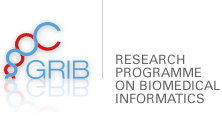Research lines
The System Pharmacology Group has two main methodological research lines, namely, research on the Chemome and the research on the Proteome. In addition to these methodological lines, we have recently initiated four therapeutic research lines directed to the disease areas of cardiovascular, obesity, pain, and oncology. A brief description of each line is provided next:
Chemome Research
Generating Chemical Graph Identifiers. Fast and robust algorithms for indexing molecules have been historically considered strategic tools for the management and storage of large chemical libraries. This lab has developed a modified and further extended version of the MEQNUM naming adaptation of the Morgan algorithm for the generation of a chemical graph identifier (CGI). This new version corrects for the collisions recognized in the original adaptation and includes the ability to deal with tautomerism, regioisomerism, optical isomerism, and geometrical isomerism.
Defining Biologically-relevant Molecular Descriptors. A novel set of molecular descriptors called SHED (SHannon Entropy Descriptors) has been developed. They are derived from distributions of atom-centered feature pairs extracted directly from the topology of molecules. Similarity between pairs of molecules is then assessed by calculating the Euclidean distance of their SHED profiles, under the assumption that molecules having similar pharmacological profiles should contain similar features distributed in a similar manner.
Constructing Virtual Chemical Spaces. The ability to generate novel synthetically-feasible biologically-active candidate molecules by computational means has long been pursued as a comprehensive and efficient approach to explore the vast chemical space potentially compatible to a given target space. We are developing a new ligand-based de novo design approach referred to as SHIFT, for Structural Hopping by Isosteric Fragment Transformations, and is based on the concept of a bioisosteric molecular shift defined as the exchange of a chemical structure for another of the same biological class.
Proteome Research
Functional coverage of the proteome by structures. Tools and resources for translating the remarkable growth witnessed in recent years in the number of protein structures determined experimentally into actual gain in the functional coverage of the proteome are increasingly necessary. The Chemogenomics Lab has developed FCP, a publicly accessible continuously updated web tool dedicated to analyzing the current state and trends of the population of structures within protein families.
SuSe: Dictionary of protein surface segments. Based on the basic assumption that similar chemical functionalities should bind to similar protein environments we are constructing an integrative database connecting small molecule fragments to protein surface segments on the basis of structural information present in the Protein Data Bank.
Therapeutic Research Lines. References to individual protein targets and bioactive small molecules associated to multifactorial diseases can be found scattered in multiple bibliographic sources over the years. Mining these sources, we are collecting lists of targets associated to four therapeutic areas, namely, cardiovascular, obesity, pain, and oncology, and organising them using functional classification schemes in the four main protein families of therapeutic relevance, namely, enzymes, G protein-coupled receptors, ion channels, and nuclear receptors. Each disease-associated target space is then taken to interrogate an annotated chemical library and extract the bioactive chemical space connected to the corresponding target space. Some of these bioactive ligands were also found to have affinity for targets not directly linked to its respective diseases, thus constituting a valuable indirect source to infer the potential disease-associated off-target space. Compilation, classification, and integration of this prior knowledge provide a comprehensive perspective of the pharmacological space relevant to modern global drug discovery.



